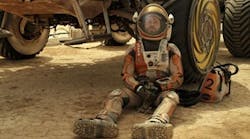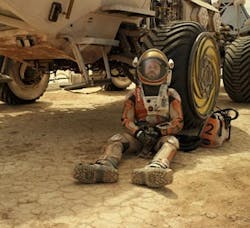Check out “The Martian” teaser trailer video.
I loved it. It actually brought a tear to my eye—even the third time I watched it. There are some very powerful science, imagery and human sides to the movie. And NASA has mentioned that “The Martian,” which will be in theaters on Oct. 2, is the most scientifically accurate film that it has ever consulted on.
Left for dead on Mars by his crew after a powerful storm, Astronaut Mark Watney (Matt Damon) must figure out how to survive with what's left of the base. About 140 million miles away, NASA and a team of scientists work vigorously to bring “the Martian” home, while his crewmates simultaneously plot a daring, if not impossible, rescue mission. As these stories of incredible bravery unfold, the world comes together to root for Watney’s safe return. With Ridley Scott as the director, get ready for a cinematic and emotional ride.
Andy Weir wrote “The Martian,” and Scott loved it so much he made this film. NASA thinks Weir's calculations are excellent, and there is a lot of science, tech and machines in the film. The scientist who advised Scott is Dr. Jim Green, director of planetary science at NASA, and I had a chance to talk with him.
Matt Damon portrays an astronaut who faces seemingly insurmountable odds as he tries to find a way to subsist on a hostile planet.
Source: Twentieth Century Fox and Twentieth Century Fox Film
For me, Mars is the ultimate destination, so I asked him when we’re going to Mars. "We are developing the next space launch system (SLS)," comments Green. "This is what will send us to Mars. It's the most powerful rocket we’ve ever built. The spacecraft, Orion, will house six astronauts. We will have the transportation systems that can drop the 40 tons of materials and supplies on the surface that will be needed. We are currently learning Mars, but the astronauts that will step foot on Mars are alive today. The capabilities and infrastructures are under development, and we will be there in the late 2030s or early 2040s and with a base in the 2050s."
Also read: How to Combat a Lack of Fundamentals in EE Degree Training
A wide range of technology highlighted in the movie is accurate. "For a Mars outpost, there are a number of challenges," notes Green. "If you don't bring your food, you have to grow it. You would need to enclosure it, use the soil and make fertilizer and water. There is far more humidity on mars than originally thought. Curiosity rover found that, and it found nitrogen to help make things grow."
There is also development underway to get us to Mars and to support us while we are there, says Green. "Development is in process for a 25 kV ion engine that will be available to take tens of tons to Mars," he continues. "To go to Mars we will need 40 tons on the ground. We'll also need radioisotope power systems and solar power to pull water out of the air. And our Mars 2020 rover mission brings in CO2 and, through electrolysis, chops off the carbon monoxide and creates oxygen."
Green would absolutely love to go to Mars, and so would I. "We are explorers," states Green. "What's on the other side of the hill? We explore for science and to survive. The science is cool, but the survival is what's important. There have been five mass extinction events in the history of the world. Stuff happens all the time. Approximately 10 tons of space material falls on the earth every day."
About 12,000 objects that could impact the earth are being tracked; some are planet killers, and some are city killers, continues Green. "We are constantly finding them. Everything looks good for the next 100 years, so no worries," he says. Seems like a good idea to have a spare planet available and the tech to get there, just in case.
"It's the math; it's the chemistry; it’s the underlying science that makes this country great," states Green. It fuels our economy, and it allows us to dream big and then fulfill it. To get to Mars, land on Mars, live and work on Mars and return home is all about science, math and chemistry. These are the skills that we will have to use to get there and to live there successfully.
If you happen to be stranded on Mars, don't worry; help is only 140 million miles away. Let’s get after the science, math and chemistry, so we can help with a few steps on Mars.







